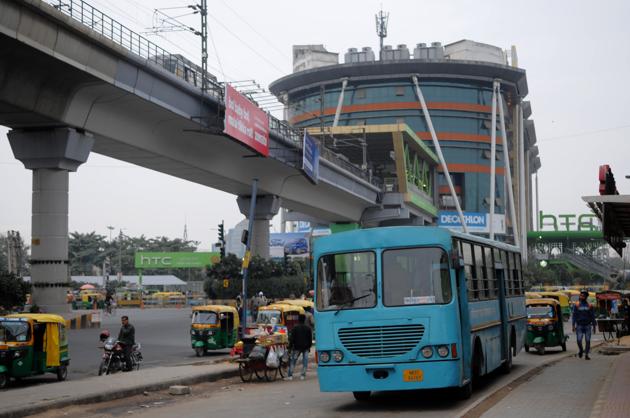Gurgaon: Lack of routes, overcrowding keep residents away from buses
City residents, who took part in a recent survey, said they are willing to switch to public transport if more routes are made available
Strap: Eye on 2037: Residents state overcrowding and absence of routes as reasons for not using buses

So why don’t you travel by buses in Gurgaon, a city that is infamous for its gridlocks and congestion? A survey conducted by the civic agencies had 27% respondents citing ‘no route’ and 18% terming ‘crowding’ as the reasons for giving buses the miss.
Respondents said they are ready to shift to public transport, provided there are proper routes and enough buses.
Currently, almost 51% travel to work using private mode of transport, followed by autorickshaws which account for 22% passenger traffic. The survey states that these auto commuters can be the potential divertible commuters if the bus system is improved.
The survey—Implementation of City Bus Service Project in Gurugram–Bus Route Planning and Rationalization—was commissioned in May by the Gurugram Metropolitan Development Authority (GMDA) and the Municipal Corporation of Gurugram (MCG). It was carried out by the Delhi Integrated Multi Modal Transit System (DIMTS).
The survey focussed on the year 2037 and proposed a total of 37 bus routes to cover the Gurgaon metropolitan area. Presently, the city has 22 bus routes on which 18 government buses and four private buses are plying.
The survey has pegged the population in metropolitan areas at 2,17,9187 by the year 2037 and has used household survey, user opinion survey, boarding and alighting survey, workplace survey, passenger count on para-transit operators and on-board passenger counts to arrive at its results.
Read I Gurgaon bus service by March 2018, says MCG commissioner
The survey was aimed at developing a bus route planning and rationalization system, taking into consideration the movement patterns of passengers in the city, demand levels, service level benchmarks, need for various types of services, land-use integration, multimodal integration, overlap services and efficiency of existing operations.
The report was submitted in early December and has been released for public feedback and suggestions.
“The vision to make a sustainable public transport available for the city is being implemented by the government and it will be visible on ground soon when new low-floor buses will ply on city roads from March next year,” MCG additional commissioner Dr Narhari Bangar said.
Even as the government proposes to launch the bus service by March-end, the residents are skeptical about that happening as many feel that “government projects are usually delayed”.
“The GMDA’s plan to ply 500 low-floor buses is welcome but we doubt it would be implemented effectively. City roads are in a bad shape and there are no bus stands. The lack of coordination among departments will be another factor that can make its implementation difficult,” Sudhir Bharadwaj, president of Sector 56 residents’ welfare association, said.
Government functionaries said the roll-out is well-planned and the Haryana government had formed the Gurugram Metropolitan City Bus Limited (GMCBL) towards this end.
“We plan to roll out 20 to 25 buses by the end of February or early March. Thereafter, every successive week, more buses will be added to take the fleet to 100 in the first phase. Electric buses will also be added to the fleet,” Anand Mohan Sharan, chief executive officer of GMDA, said.
A total of about 500 buses are proposed to be deployed in Gurgaon in five phases. The GMCBL plans to select different operators for each phase. In each of the first two phases, 100 buses are proposed to be deployed, an official spokesperson said.
Aside from the number of buses, experts suggest, the city needs buses of different sizes on different routes.
Dr Sewa Ram, transport expert, School of Planning and Architecture (SPA), New Delhi, said, “The government should launch small-size buses, besides low-floor big buses. The government should accordingly ply these buses on trunk roads, primary roads and secondary roads. On all these roads, success of plan would depend on the frequency with which the buses shuttle.”
This need for different size of buses is also reflected in the travel pattern of commuters, 33% of whom have either their origin or destination outside Gurgaon. While Delhi accounts for 29.5% commuter traffic, the remaining 67% trips are within the Gurgaon metropolitan area.
Within Gurgaon, HUDA City Centre emerged as a key boarding and alighting point for passengers.
About 16.3% bus users board from the HUDA City Centre bus stop, followed by 7.3% at Mahaveer Chowk and 7.2% boarding from the Gurgaon bus stand.
Similarly, the alighting patterns of passengers show highest demand, by 8% passengers, for buses to terminate at the HUDA City Centre, followed by 4.8% passenger traffic at Gurgaon bus stand, and Mahaveer Chowk with 4.5 %.
With Metro spreading fast across Gurgaon, commuters’ response showed need for buses to run on short routes, with more than 60% respondents emphasizing need for medium-length routes of 3 to 5km.
“An effective public transport solution is a must in a city and Gurgaon requires is with utmost urgency. We hope the bus service will help improve the air quality and reduce congestion on city roads,” Sarika Panda, manager, Cities and Transport, World Resources Institute (WRI), India, said.
Stay updated with all the Breaking News and Latest News from Mumbai. Click here for comprehensive coverage of top Cities including Bengaluru, Delhi, Hyderabad, and more across India along with Stay informed on the latest happenings in World News.
Stay updated with all the Breaking News and Latest News from Mumbai. Click here for comprehensive coverage of top Cities including Bengaluru, Delhi, Hyderabad, and more across India along with Stay informed on the latest happenings in World News.





